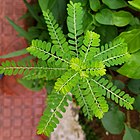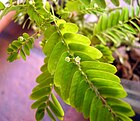Note: This is a project under development. The articles on this wiki are just being initiated and broadly incomplete. You can Help creating new pages.
Difference between revisions of "Phyllanthus niruri"
| Line 1: | Line 1: | ||
| − | + | [[File:Phyllanthus niruri 03520.jpg |thumb|right|'''Phyllanthus niruri''']] | |
| + | '''Phyllanthus niruri''' is a widespread tropical plant commonly found in coastal areas, known by the common names gale of the wind, stonebreaker or seed-under-leaf. It is a relative of the spurges, belonging to the genus Phyllanthus of the family Phyllanthaceae. | ||
==Uses== | ==Uses== | ||
| − | {{Uses|}}, {{Uses|}}, {{Uses|}}, {{Uses|}} | + | {{Uses|Jaundice}}, {{Uses|Gonorrhea}}, {{Uses|Frequent menstruation}}, {{Uses|Diabetes}} |
==Parts Used== | ==Parts Used== | ||
| − | {{Parts Used| | + | {{Parts Used|Leaves}}. |
==Chemical Composition== | ==Chemical Composition== | ||
| + | It occurance of terpenoids, alkaloids, glycosides, flavonoids, tannins, and saponins. | ||
<ref name="chemical composition"/> | <ref name="chemical composition"/> | ||
==Common names== | ==Common names== | ||
| − | {{Common names | + | {{Common names|kn=ಕಿರುನೆಲ್ಲಿ Kiru Nelli|ml=Kilanelli |sa=bahupatra, भूम्यामलकी bhumyaamalaki|ta=கீழாநெல்லி keelanelli, கீழ்காய்நெல்லி kizkaynelli|te=నేల ఉసిరి nela usiri|hi=भूई आंवला Bhui aonla, जड़ आमला Jaramla, जंगली अमली Jangli amli|en=Carry Me Seed, Black catnip, Child pick-a-back, Gale of wind, Gulf leaf flower, Hurricane weed, Shatterstone, Stone breaker}} |
==Properties== | ==Properties== | ||
Reference: Dravya - Substance, Rasa - Taste, Guna - Qualities, Veerya - Potency, Vipaka - Post-digesion effect, Karma - Pharmacological activity, Prabhava - Therepeutics. | Reference: Dravya - Substance, Rasa - Taste, Guna - Qualities, Veerya - Potency, Vipaka - Post-digesion effect, Karma - Pharmacological activity, Prabhava - Therepeutics. | ||
===Dravya=== | ===Dravya=== | ||
| + | |||
===Rasa=== | ===Rasa=== | ||
| − | |||
===Guna=== | ===Guna=== | ||
| Line 29: | Line 31: | ||
==Habit== | ==Habit== | ||
| − | {{Habit|}} | + | {{Habit|Tree}} |
==Identification== | ==Identification== | ||
===Leaf=== | ===Leaf=== | ||
| − | {{Leaf|||}}<ref name="Leaf"/> | + | {{Leaf|Simple|Oblong-elliptic or squarish leaves|Glabrous, about 6-12 mm long}}<ref name="Leaf"/> |
===Flower=== | ===Flower=== | ||
| − | {{Flower||||}} | + | {{Flower|Bisexual||Yellow||The flowers produce very small (2mm)}} |
| − | |||
| − | |||
===Other features=== | ===Other features=== | ||
| Line 46: | Line 46: | ||
==Where to get the saplings== | ==Where to get the saplings== | ||
| − | |||
==Mode of Propagation== | ==Mode of Propagation== | ||
| − | {{Propagation|}} | + | {{Propagation|Seeds}}. |
==How to plant/cultivate== | ==How to plant/cultivate== | ||
| + | Drip irrigation permitted successful cultivation during the dry season. Plastic mulch was used to control weeds. Phyllanthus amarus grows slowly, and reaches a maximum size and vigor at about 5–7 months after sowing. | ||
<ref name="How to plant/cultivate"/> | <ref name="How to plant/cultivate"/> | ||
==Commonly seen growing in areas== | ==Commonly seen growing in areas== | ||
| − | {{Commonly seen| | + | {{Commonly seen|Lowland forest}}. |
==Photo Gallery== | ==Photo Gallery== | ||
<gallery class="left" caption="" widths="140px" heights="140px"> | <gallery class="left" caption="" widths="140px" heights="140px"> | ||
| − | + | File:Phyllanthus niruri .jpg | |
| + | File:Quebra-Pedra. Phyllanthus niruri.JPG | ||
| + | File:Phyllanthus niruri.jpg | ||
</gallery> | </gallery> | ||
==References== | ==References== | ||
| + | |||
<references> | <references> | ||
| + | <ref name="chemical composition">[https://www.ncbi.nlm.nih.gov/pmc/articles/PMC6222918/#:~:text=Chemical%20Components,major%20constituents%20of%20Phyllanthus%20plants. Chemical composition]</ref> | ||
| − | <ref name=" | + | <ref name="Leaf">[http://www.flowersofindia.net/catalog/slides/Carry%20Me%20Seed.html Morphology]</ref> |
| − | |||
| − | |||
| − | <ref name="How to plant/cultivate">[ | + | <ref name="How to plant/cultivate">[https://link.springer.com/article/10.1007/BF02862208#:~:text=Drip%20irrigation%20permitted%20successful%20cultivation,5%E2%80%937%20months%20after%20sowing.&text=amarus%20was%20produced%20when%20seeds,winter%20for%20a%20summer%20harvest. Cultivation Details]</ref> |
| − | |||
</references> | </references> | ||
==External Links== | ==External Links== | ||
| − | * [ ] | + | * [http://www.theplantlist.org/tpl1.1/record/kew-2733595 Phyllanthus niruri] |
| − | + | ||
| − | + | ||
[[Category:Herbs]] | [[Category:Herbs]] | ||
| − | [[Category: | + | [[Category:Phyllanthaceae]] |
Revision as of 16:02, 15 June 2020
Phyllanthus niruri is a widespread tropical plant commonly found in coastal areas, known by the common names gale of the wind, stonebreaker or seed-under-leaf. It is a relative of the spurges, belonging to the genus Phyllanthus of the family Phyllanthaceae.
Contents
- 1 Uses
- 2 Parts Used
- 3 Chemical Composition
- 4 Common names
- 5 Properties
- 6 Habit
- 7 Identification
- 8 List of Ayurvedic medicine in which the herb is used
- 9 Where to get the saplings
- 10 Mode of Propagation
- 11 How to plant/cultivate
- 12 Commonly seen growing in areas
- 13 Photo Gallery
- 14 References
- 15 External Links
Uses
Jaundice, Gonorrhea, Frequent menstruation, Diabetes
Parts Used
Chemical Composition
It occurance of terpenoids, alkaloids, glycosides, flavonoids, tannins, and saponins. [1]
Common names
| Language | Common name |
|---|---|
| Kannada | ಕಿರುನೆಲ್ಲಿ Kiru Nelli |
| Hindi | भूई आंवला Bhui aonla, जड़ आमला Jaramla, जंगली अमली Jangli amli |
| Malayalam | Kilanelli |
| Tamil | கீழாநெல்லி keelanelli, கீழ்காய்நெல்லி kizkaynelli |
| Telugu | నేల ఉసిరి nela usiri |
| Marathi | NA |
| Gujarathi | NA |
| Punjabi | NA |
| Kashmiri | NA |
| Sanskrit | bahupatra, भूम्यामलकी bhumyaamalaki |
| English | Carry Me Seed, Black catnip, Child pick-a-back, Gale of wind, Gulf leaf flower, Hurricane weed, Shatterstone, Stone breaker |
Properties
Reference: Dravya - Substance, Rasa - Taste, Guna - Qualities, Veerya - Potency, Vipaka - Post-digesion effect, Karma - Pharmacological activity, Prabhava - Therepeutics.
Dravya
Rasa
Guna
Veerya
Vipaka
Karma
Prabhava
Habit
Identification
Leaf
| Kind | Shape | Feature |
|---|---|---|
| Simple | Oblong-elliptic or squarish leaves | Glabrous, about 6-12 mm long |
Flower
| Type | Size | Color and composition | Stamen | More information |
|---|---|---|---|---|
| Bisexual | Yellow | The flowers produce very small (2mm) |
Other features
List of Ayurvedic medicine in which the herb is used
Where to get the saplings
Mode of Propagation
How to plant/cultivate
Drip irrigation permitted successful cultivation during the dry season. Plastic mulch was used to control weeds. Phyllanthus amarus grows slowly, and reaches a maximum size and vigor at about 5–7 months after sowing. [3]
Commonly seen growing in areas
Photo Gallery
References
External Links
- Ayurvedic Herbs known to be helpful to treat Jaundice
- Ayurvedic Herbs known to be helpful to treat Gonorrhea
- Ayurvedic Herbs known to be helpful to treat Frequent menstruation
- Ayurvedic Herbs known to be helpful to treat Diabetes
- Herbs with Leaves used in medicine
- Herbs with common name in Kannada
- Herbs with common name in Hindi
- Herbs with common name in Malayalam
- Herbs with common name in Tamil
- Herbs with common name in Telugu
- Herbs with common name in Sanskrit
- Herbs with common name in English
- Habit - Tree
- Index of Plants which can be propagated by Seeds
- Herbs that are commonly seen in the region of Lowland forest
- Herbs
- Phyllanthaceae



